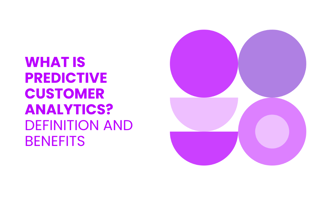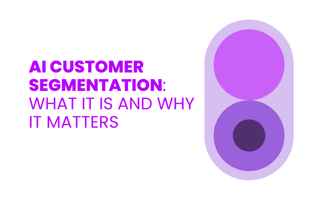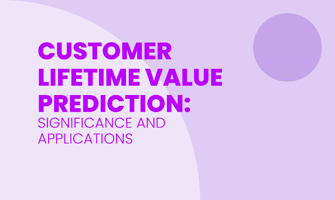In B2B markets, competition is high, and customer behavior keeps changing. Many companies lose...
Predictive Customer Analytics: Definition and How It Works
Your B2B business cannot afford to guess what customers will do next. Wasting time on the wrong leads, missing signs that a client might leave, or failing to spot new opportunities can slow down growth and hurt revenue. Without clear insights, every decision becomes a risk.
This is where predictive customer analytics helps you stay ahead. By using your data to understand future customer behavior, you can focus on the right actions at the right time. This article explains what predictive customer analytics is, how it works, and how your B2B business can simplify the process with 180ops.
Our article "How Customer Data Analytics Improves ROI" explains it all.
What Is Predictive Customer Analytics?
Predictive customer analytics is the process of using data to guess what your customers might do next. It looks at past customer behavior, finds patterns, and helps businesses understand what is likely to happen in the future. This process uses tools like data analysis, artificial intelligence, and machine learning to make accurate predictions about customer actions.
In a B2B business, predictive customer analytics focuses on understanding the behavior of other companies you work with. It helps you see which business clients are ready to buy, which ones might stop using your services, and where new opportunities can appear. Instead of working with guesses, your B2B business can use real data to plan smarter moves with customers.
Benefits of Predictive Customer Analytics for B2B Businesses
Predictive customer analytics helps your B2B business grow revenue by showing where to focus your sales efforts. It points out which customers are most likely to buy, so your team spends time on deals that can close faster and bring in more income.
It helps reduce customer churn by warning you when a client might leave. Your business can act early to fix problems, improve relationships, and keep valuable customers before they decide to go.
Your B2B business can improve marketing by targeting the right audience. Predictive customer analytics tells you which businesses are interested in your services, so you can send messages that matter to them.
It also supports better planning by giving clear forecasts. Your business can use these predictions to make smarter decisions about resources, budgets, and future strategies based on what is likely to happen.
Key Components of Predictive Customer Analytics
1. Customer Data
Customer data is the information a business collects about its customers. This includes details like purchase history, website visits, emails, customer support interactions, and even information from social media or market trends. Both internal data, which comes from your own systems, and external data, which comes from outside sources, are important for understanding customer behavior.
Without customer data, predictive customer analytics cannot work. This data is the starting point because it shows what customers have done in the past. By looking at this information, businesses can start to see patterns. These patterns help predict what customers might do next, like buying again or leaving for a competitor. The more complete and accurate the data, the better the predictions will be.
2. Data Management Tools
Data management tools help businesses store, organize, and clean customer data. When data comes from many places, it can be messy or incomplete. These tools make sure that all the data is in one place, easy to access, and ready for analysis. They also remove duplicate entries and fix errors, so the information is reliable.
Good data management is important because predictive customer analytics depends on accurate data. If the data is disorganized or incorrect, the predictions will be wrong. These tools ensure that businesses can trust their data before using it in any analysis. They also save time by automating tasks that would be too slow to do manually.
3. Smart Algorithms and Machine Learning
Smart algorithms and machine learning are the technologies that find patterns in customer data. An algorithm is a set of instructions a computer follows to solve a problem. Machine learning allows these algorithms to improve over time as they process more data. Together, they help predict customer behavior by recognizing trends that people might miss.
This component is critical because it turns raw data into useful insights. Algorithms can predict things like which customers are likely to buy soon or which ones might stop using a service. Machine learning makes these predictions more accurate as it learns from new data.
4. Insight Dashboards
Insight dashboards are simple screens where businesses can see the results of predictive customer analytics. They show important information in charts, graphs, and summaries. Instead of looking at complex data tables, teams can quickly understand what is happening and what actions they should take.
5. Action Plans from Insights
Action plans from insights are the final step where predictions are turned into real business moves. After understanding what the data says, businesses need to decide what to do next. This could be reaching out to customers who are likely to buy, offering special deals to those at risk of leaving, or adjusting marketing campaigns based on predicted behavior.
This component is important because insights alone do not create value unless they lead to action. Predictive customer analytics helps businesses stay ahead by suggesting clear next steps. When teams follow these action plans, they can improve customer satisfaction, increase sales, and reduce the chance of losing customers.
Streamline Predictive Customer Analytics for B2B with 180ops
1. Connect All Your Customer Data in One Place
180ops connects your B2B business systems by bringing together customer data from CRM, marketing, finance, customer service, and external sources. You do not need to manage different platforms or worry about missing information. 180ops organizes your account-based customer data along with market trends and economic signals in one place.
This connected view helps your business understand each customer’s current situation, growth potential, and buying readiness. By removing manual data handling, 180ops gives you a clear foundation to start predictive customer analytics without delays or errors.
2. Let AI and Machine Learning Find Patterns for You
180ops uses AI and machine learning to analyze your connected data automatically. The platform looks for patterns like customer interest, sales opportunities, and churn risks without needing manual input from your team. It continuously learns from new data, making predictions more accurate over time.
Your B2B business benefits from instant insights into customer behavior and market changes. You do not have to build models or run complicated reports. 180ops does the technical work for you, helping you recognize important trends and act quickly.
3. Get Clear Forecasts on Sales and Customer Behavior
180ops provides your business with real-time forecasts based on your customer data and external factors. It predicts sales outcomes, customer churn risks, market potential, and overall business performance. These forecasts are built on evidence, not assumptions.
With 180ops, your business gets straightforward predictions that guide your sales and marketing strategies. You know which customers are ready to buy, where risks exist, and how to adjust your actions for better results. The platform turns complex forecasting into simple insights your teams can use every day.
4. See Easy-to-Read Tips and Next Steps
180ops does more than just show data. It gives your B2B business clear tips on what to do next. After analyzing your customer data, the platform translates complex information into simple, practical recommendations. You do not have to guess what actions to take because 180ops highlights where to focus.
These tips help your sales and marketing teams know which customers to contact, which deals to prioritize, and where potential risks need attention. The platform removes confusion by turning data insights into easy steps your teams can follow. This means faster decisions and better outcomes without needing deep data expertise.
5. Help Every Team Make Better Decisions
Predictive customer analytics is not just for data teams. With 180ops, every part of your B2B business gets the insights it needs. The platform provides tailored dashboards for sales, marketing, finance, customer service, and executives. Each team sees information that matters to their role.
Sales teams can spot ready-to-buy customers. Marketing can target the right audience. Finance can trust accurate forecasts. Executives get a full view of business performance. 180ops ensures that everyone works with the same reliable data, helping your business stay aligned and focused on growth.
6. Start Seeing Results in Just 4 Weeks
Many analytics tools take a long time to set up. 180ops is different. Your B2B business can start getting value within 4 weeks. The platform quickly connects to your internal systems and external data sources. Once connected, it delivers actionable insights without long waiting periods.
In this short time, your teams will have a clear view of your customers, sales pipeline, and market opportunities. You can begin focusing your efforts where they matter most and start improving results fast. 180ops is built to remove delays and help your business act on predictive insights right away.
Conclusion
Predictive customer analytics gives your B2B business the power to make smarter decisions by using data to understand what customers are likely to do next. It helps you focus on the right opportunities, reduce risks, and plan with confidence. Without it, you are left making guesses that can cost time and revenue. In today’s competitive market, relying on outdated methods or assumptions can slow your growth and put your customer relationships at risk.
180ops is a revenue intelligence platform designed to handle your predictive customer analytics needs with ease. It connects your data, uses AI and machine learning to find patterns, and delivers clear insights your teams can act on. With 180ops, your business can move from reactive decisions to proactive strategies powered by real-time data.
Contact us to take control of your customer predictions and drive smarter growth for your B2B business.
FAQ
What is predictive customer analytics?
Predictive customer analytics uses data, AI, and machine learning to forecast what customers are likely to do next.
How does predictive customer analytics work?
It analyzes past customer behavior to find patterns and predict future actions like buying, leaving, or engaging.
What are examples of predictive customer analytics?
Examples include predicting customer churn, identifying sales opportunities, and personalizing marketing campaigns.
What are the benefits of predictive customer analytics?
It helps businesses increase sales, reduce customer loss, improve marketing efforts, and make better decisions.
How to implement predictive customer analytics in a business?
Start by collecting customer data, using analytics tools to find patterns, and applying insights to guide your actions. You can simplify this process by using a platform like 180ops to handle data integration, analysis, and insights for you.




